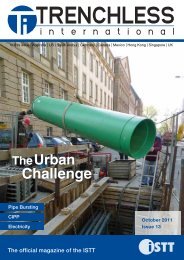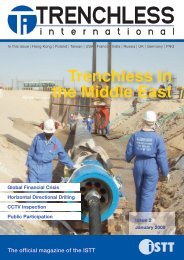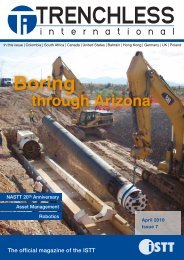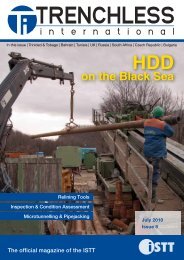North American Special - Trenchless International
North American Special - Trenchless International
North American Special - Trenchless International
You also want an ePaper? Increase the reach of your titles
YUMPU automatically turns print PDFs into web optimized ePapers that Google loves.
north america<br />
April 2009 - <strong>Trenchless</strong> <strong>International</strong><br />
HRX: heading across the harbour<br />
A record was recently set on the Virginia Natural Gas Hampton Roads Crossing (HRX) HDD bore.<br />
Project Manager Les Flora spoke with <strong>Trenchless</strong> <strong>International</strong> about the innovative and challenging<br />
project.<br />
The aim of the project is to support<br />
distribution company Virginia Natural Gas<br />
(VNG), a subsidiary of AGL resources.<br />
The project itself comprises 21 miles<br />
of 24 inch diameter pipeline, extending<br />
transmission gas facilities under Hampton<br />
Roads Harbour, Virginia. The harbour is<br />
one of the largest natural harbours in the<br />
world. The harbour is also home to the<br />
largest naval base in the world and has<br />
a significantly high degree of commercial<br />
maritime traffic. The crossing of the harbour<br />
itself includes four miles of pipeline<br />
from Newport News to Newport News.<br />
In addition the project involves an<br />
HDD crossing of the Elizabeth River.<br />
This crossing demanded a 7,300 feet<br />
(2,225 metres) HDD drive in 24 inch pipeline<br />
– a bore record.<br />
Project Scope<br />
Currently, the VNG distribution system is<br />
divided into two non-contiguous pipeline<br />
systems – southern and northern – due<br />
to the geography of the Hampton Roads<br />
harbour. On a peak day, each system is<br />
fed by a single gas supplier; Columbia<br />
Gas Transmission in the Southern system<br />
and Dominion Transmission in the<br />
<strong>North</strong>ern system, making them vulnerable<br />
to gas disruptions. This project will ensure<br />
reliability of supply and future availability.<br />
The project includes the construction<br />
of approximately three miles of onshore<br />
pipeline in Hampton, four miles of onshore<br />
pipeline in Newport News, four miles of<br />
onshore pipeline in Norfolk, and ten miles<br />
crossing the Hampton Roads Harbour.<br />
The project will also include upstream<br />
pipeline compression facilities in Hanover<br />
and Charles City Counties, and a city<br />
gate station at the termination point in<br />
Norfolk.<br />
Design and construction<br />
The marine construction project team<br />
included Weeks Marine, Mears Horizontal<br />
Directional Drilling and Bradford<br />
Brothers.<br />
Weeks Marine is the general contractor<br />
on the marine portion, providing all of<br />
the marine equipment and diver support.<br />
Mears and Weeks teamed up to complete<br />
the HDD with their pipeline subcontractor,<br />
Bradford Brothers.<br />
Crossing the harbour<br />
The harbour crossing consists of five<br />
separate HDDs ranging in length from<br />
3,000 – 3,800 feet.<br />
Mr Flora said that <strong>Trenchless</strong><br />
Technology was selected for a number<br />
of reasons. The two main drivers were<br />
the environmental permits and the US<br />
Army Corps permits required as the pipe<br />
path bisected an anchorage area.<br />
The Marine Resources Commission<br />
is very active in protecting the area.<br />
Alternative methods such as conventional<br />
dredging, laying pipe on the bottom<br />
or even jetting it in were considered.<br />
However, Mr Flora said that “because of<br />
the environmental impacts, or I should<br />
say, perceived environmental impacts,<br />
the Marine Resources Commission would<br />
not permit it. So we had to directionally<br />
drill under their biggest area of concern.<br />
“On the Army Corp side there is<br />
approximately 5,000 feet of pipe to go<br />
under an anchorage area. The anchorage<br />
space is so valuable to the maritime<br />
community that the decision was made<br />
to directionally drill this section of the<br />
pipeline.”<br />
Finally, a natural shipping channel is<br />
also a part of this crossing. Mr Flora said<br />
that the company was aware that this<br />
section would be directionally drilled in<br />
order to reach the depth that would be<br />
required under the channel.<br />
The depth of the channel is 15 metres<br />
with a design depth of 19 metres. The<br />
drill path was required to be a minimum<br />
of 6 metres under the design<br />
depth. Therefore the shipping channel<br />
drill was approximately 25 metres below<br />
the water.<br />
Mr Flora continued “Three of [the<br />
drives] are marine to marine drills so<br />
we’re drilling from a barge and the<br />
receiving rig is on another barge.<br />
“We’re building those pipe sections<br />
out on the end of Craney Island, which<br />
is basically a beach, out into the harbour<br />
and then towing those sections by tying<br />
them to tug boats. Towing them off the<br />
end of the island and floating them into<br />
place and then sinking them and then<br />
hooking them back to the drill rigs for<br />
the pull back.”<br />
Mr Flora said there is also another area<br />
requiring trenchless expertise. “We are<br />
doing a bunch of small directional drills,<br />
on the Upland piece of this project. We<br />
have 7 miles (11.2 km) of pipe on land<br />
in Newport news, and about 4 miles (6.4<br />
km) in Norfolk. They are very heavily<br />
urban quarters, there are just not a lot of<br />
good places to put pipe, much less 24<br />
inch pipe.”<br />
For example, for the first mile onshore<br />
of Newport News, the pipe was directionally<br />
drilled under a tidal wetland creek as<br />
there was not a less congested route for<br />
the pipe. This pipe was separated into<br />
two drills, each approximately 2,800 feet<br />
(853 metres). Mr Flora said that space<br />
was incredibly tight, “the pipe looked<br />
like a pretzel wrapped around a tree.”<br />
Mr Flora said that without <strong>Trenchless</strong><br />
Technology the sections directionally<br />
drilled, in most cases, could not have<br />
been completed in an alternative method<br />
in a cost effective way.<br />
A challenging crossing<br />
The Elizabeth River crossing was one<br />
of the most ambitious and challenging<br />
parts of the project as this demanded<br />
the laying out of a string of pipe 7,300<br />
ft long.<br />
Fortunately Craney island, a government<br />
owned area, is located right in<br />
the middle of the project. The island<br />
is a US Army Corps dredge disposal<br />
management area. The contractors had<br />
to share the very small island area with<br />
Army Corp Engineers and the associated<br />
traffic.<br />
Mr Flora explained that the Dominion<br />
University is located on the other side of<br />
the river where the pipe was to be pulled<br />
back. During the semester this area is<br />
filled with approximately 24,000 students.<br />
Therefore the team could only operate<br />
from 12 May until 20 August.<br />
Elizabeth River Crossing: pullback.<br />
Elizabeth River Crossing.<br />
Harbour Crossing: pull head with<br />
hose connections for pipe flooding.<br />
Elizabeth River Crossing: pullback.<br />
north america<br />
April 2009 - <strong>Trenchless</strong> <strong>International</strong><br />
62<br />
63
















